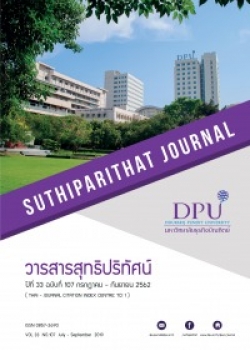ระบบพัฒนาสมรรถนะครูและบุคลากรทางการศึกษาด้วยเทคโนโลยีสารสนเทศ
คำสำคัญ:
ระบบ, สมรรถนะ, ครู, บุคลากรทางการศึกษา, เทคโนโลยีสารสนเทศบทคัดย่อ
กระทรวงศึกษาธิการนำเทคโนโลยีสารสนเทศมาเป็นเครื่องมือในการพัฒนาสมรรถนะครูและ บุคลากรทางการศึกษาในหลายโครงการ ซึ่งแต่ละโครงการต้องใช้ทรัพยากรจำนวนมาก ดังนั้นจึงจำเป็นต้องมีแผนยุทธศาสตร์ที่เหมาะสมในการทำงานดังกล่าว การวิจัยครั้งนี้มีวัตถุประสงค์เพื่อ 1) พัฒนาระบบพัฒนาสมรรถนะครูและบุคลากรทางการศึกษาด้วยเทคโนโลยีสารสนเทศ และ 2) พัฒนาแผนยุทธศาสตร์ด้านการพัฒนาสมรรถนะครูและบุคลากรทางการศึกษาด้วยเทคโนโลยีสารสนเทศ โดยใช้ 1) แบบสอบถาม จำนวน 3 ชุด 2) ประเด็นการสนทนากลุ่ม 3 ชุด 3) แบบสัมภาษณ์ และ 4) แบบบันทึกความคิดเห็นของผู้เชี่ยวชาญ สถิติที่ใช้สำหรับการวิเคราะห์เพื่อตอบปัญหาวิจัย ได้แก่ การวิเคราะห์สหสัมพันธ์แบบเพียร์สัน การวิเคราะห์เปรียบเทียบความแตกต่างของค่าเฉลี่ยโดยใช้สถิติทดสอบค่าที และการวิเคราะห์องค์ประกอบเชิงยืนยันอันดับที่สอง ผลการวิจัยพบว่า ระบบการพัฒนาสมรรถนะของครูและบุคลากรทางการศึกษาระดับการศึกษาขั้นพื้นฐานด้วยเทคโนโลยีสารสนเทศ มี 4 องค์ประกอบ 8 ขั้นตอน แผนยุทธศาสตร์ด้านการพัฒนาสมรรถนะครูและบุคลากรทางการศึกษา สำนักงานคณะกรรมการการศึกษาขั้นพื้นฐาน ประกอบด้วย 5 ยุทธศาสตร์ อาทิ 1) สร้างระบบกำกับดูแล สนับสนุนส่งเสริมและเชื่อมโยงการใช้เทคโนโลยีสารสนเทศในการ บริหารจัดการฝึกอบรมของทุกหน่วยงาน 2) พัฒนาขีดความสามารถของครูและบุคลาการทางการศึกษา ในการใช้เทคโนโลยีสารสนเทศอย่างมีประสิทธิภาพเพื่อการพัฒนาตนเองอย่างมีวิจารณญาณ รู้เท่าทัน คุณธรรมและจริยธรรม 3) จัดสรรทรัพยากรด้านเทคโนโลยีสารสนเทศที่ทันสมัยสำหรับทุกภาคส่วนเพื่อการพัฒนาสมรรถนะ
เอกสารอ้างอิง
พสุ เดชะรินทร์. (2546). เส้นทางจากกลยุทธ์สู่การปฏิบัติด้วย Balanced Scorecard และ Key Performance Indicators (พิมพ์ครั้งที่ 8). กรุงเทพฯ: โรงพิมพ์แห่งจุฬาลงกรณ์มหาวิทยาลัย.
พิบูล ทีปะปาล. (2551). การจัดการเชิงกลยุทธ์. กรุงเทพฯ: อมรการพิมพ์.
เลขาธิการสภาการศึกษา, สำนักงาน. (2556). แผนการศึกษาแห่งชาติ พ.ศ. 2560 – 2579. กรุงเทพฯ: วี.ที.ซี. คอมมิวนิเคชั่น.
สำนักงานคณะกรรมการข้าราชการพลเรือน. (2547). คู่มือการบริหารงานพนักงานราชการ 2547. กรุงเทพฯ: โรงพิมพ์สำนักบริหารกลาง สำนักงาน ก.พ.
สำนักงานคณะกรรมการข้าราชการพลเรือน. (2553). คู่มือการจัดระดับการกำกับดูแลองค์การภาครัฐตามหลักธรรมาภิบาลของการบริหารกิจการบ้านเมืองที่ดี (Good Governance Rating). กรุงเทพฯ: บริษัทพรีเมียร์โปร จำกัด.
Al-bataineh, A., Anderson, S., Toledo, C., & Wellinski, S. (2008). A study of technology integration in the classroom. International Journal of Instructional Media, 35, 381-387.
Altarawneh, I. (2011). Training and development effectiveness. Saarbrücken: LAP Lambert Academic Publishing.
Anderson, R. E., & Dexter, S. (2005). School technology leadership: An empirical investigation of prevalence and effect. Educational Administration Quarterly, 41(1), 49-82.
Azmi, I. A., Ahmad, Z., & Zainuddin, Y. (2009). Competency-based pay and service quality: an empirical study of Malaysian public organizations. Asian Academy of Management Journal, 14(1), 21-36.
Bates, T. (2010). How useful is strategic planning for e-learning?. Retrieved December 14, 2018, from https://www.tonybates.ca/2010/03/28/how-useful-is-strategic-planning-for-e-learning/
Blume, B. D., Ford, J. K., Baldwin, T. T., & Huang, J. L. (2010). Transfer of training: A meta-analytic review. Journal of Management, 36, 1065-1105.
Bennis, W.G., & Nanus, B. (2003). Leaders: The strategies for taking change (3rd ed.). New York: NY: Harper Collins Pub.
Buabeng-Andoh, C. (2012). Factors influencing teachers’ adoption and integration of information and communication technology into teaching: A review of the literature. International Journal of Education and Development using Information and Communication Technology (IJEDICT), 8, 136-155.
Callan, V. J., & Bowman, K. (2010). Sustaining e-learning innovations: Literature review. The University of Queensland Business School. Retrieved December 14, 2018, from flexiblelearning.net.au.
Chen, C., Huang, J., & Hsiao, Y. (2010). Knowledge management and innovativeness: The role of organizational climate and structure. International Journal of Manpower, 31(8), 848-870.
Christensen, C., & Raynor, M. (2013). The innovator’s solution: Creating and sustaining successful growth. Boston, Massachusetts: Harvard Business Review Press.
Chyung, S.Y. (2010). 10 steps evaluation for training and performance. Los Angeles: Sage Publications.
Crossan, M.M., & Berdrow, I. (2005). Organizational learning and strategic renewal. Strategic Management Review, 24(11), 1087-1105.
De Rijdt, C., Stes, A., Van der Vleuten, A., & Dochy, F. (2013). Influencing variables and moderators of transfer of learning to the workplace within the area of staff development in higher education: Research review. Educational Research Review, 8, 48-74.
Dexter, S. (2008). Leadership for IT in schools. In J. Vooyt & G. Knezek (Eds.). International Handbook of Information Technology in Primary and Secondary Education, 543-554. Springer. doi: 10.1007/978-0-387-73315-9-32.
Didiot-Cook, H. (2013). From enthusiasm to strategy: Four critical factors to sustain the development of technology enhanced learning in educational organizations. Proceedings of 6th International LINC Conference MIT. Cambridge, Massachusetts, USA.
Dubois D. D., & Rothwell, J.W. (2004). Competency – based human resource management. California: Davies – Black Publishing.
Fisher, L., Hilton, J, Robinson, J., & Wiley, D. (2015). A multi-institutional study of the impact of open textbook adoption on the learning outcomes of post-secondary students. Journal of Computing in Higher Education, 27(3), 159-172.
Food and Agriculture Organization of the United Nations. (2011). E-learning methodologies: A guide for designing and developing e-learning courses. Retrieved December 14, 2018, from http://www.fao.org/docrep/015/i2516e/i2516e.pdf.
Garrison, D., & Anderson, T. (2011). E-learning in the 21st century: A framework for research and practice (2nd ed.). London: Routledge/Falmer.
Garrison, R., & Vaughan, N. (2007). Blended learning in higher education framework, principles, and guidelines. New York: Jossey-Bass.
Goold, M., & Campbell, A. (2008). Designing effective organizations: How to create structured networks. San Francisco, CA: Jossey-Bass.
Ho, C., & Dzeng, R. (2010). Construction safety training via e-learning: Learning effectiveness and user satisfaction. Computers & Education, 55(2), 858-867.
Hutchison, A., & Reinking, D. (2011). Teacher’s perception of integrating information and communication
technologies into literacy instruction: A National Survey in the US. Reading Research Quarterly, 46, 308-329.
Hunger, J. D., & Wheelan, T. L. (2003). Essentials of strategic management. Upper Saddle River, NJ: Prentice Hall.
Joshua, H., & Joni, B. (2005). Work environment characteristics and implications for training transfer: A case study of the nuclear power industry. Human Resource Development International, 8(1), 65-80.
Khan, N., & Sikes, J. (2014). IT under pressure: McKinsey Global Survey Results. McKinsey & Company.
Kouzes, J. M., & Posner, B. Z. (2012). The leadership challenge: How to make extraordinary things happen in organizations (5th ed.). San Francisco, CA: Jossey-Bass.
Liu, Y., & Szabo, Z. (2009). Teachers’ attitudes toward technology integration in schools: A four-year study.
Teachers and Teaching: Theory and Practice, 15(1), 5-23.
Liu, Y. C., Huang, Yu-An., & Lin, C. (2012). Organizational factors’ effects on the success of e-learning systems and organizational benefits: An empirical study in Taiwan. The International Review of Research in Open and Distributed Learning, 13(4), 130-151 doi:http://dx.doi.org/10.19173/irrodl.v13i4.1203
Morris, T. (2006). Translating management ideas. Organization Studies, 27(2), 207-233.
Pearce, J. A. & Robinson, R. B. (2000). Strategic management: Formulation, implementation, and control (6th ed.). Boston: Irwin/McGraw-Hill.
Rogers, E.M. (2003). Diffusion of innovations (5th ed.). New York: FreePress.
Salmon, G. (2011). E-moderating: The key to teaching and learning online (3rd ed.). New York: Routledge.
Tourish, D. (2008). Challenging the transformational agenda: Leadership theory in transition. Management Communication Quarterly, 21(4), 522-528.
Yuan, L., & Powell, S. (2013). MOOCs and disruptive innovation: Implications for higher education. E-Learning Papers, 33(2), 1-7.
ดาวน์โหลด
เผยแพร่แล้ว
รูปแบบการอ้างอิง
ฉบับ
ประเภทบทความ
สัญญาอนุญาต
เนื้อหาและข้อมูลในบทความที่ลงตีพิมพ์ในวารสารสุทธิปริทัศน์ ถือเป็นข้อคิดเห็นและความรับผิดชอบของผู้เขียนบทความโดยตรงซึ่งกองบรรณาธิการวารสาร ไม่จำเป็นต้องเห็นด้วย หรือร่วมรับผิดชอบใด ๆ
บทความ ข้อมูล เนื้อหา รูปภาพ ฯลฯ ที่ได้รับการตีพิมพ์ในวารสารสุทธิปริทัศน์ ถือเป็นลิขสิทธิ์ของวารสารสุทธิปริทัศน์หากบุคคลหรือหน่วยงานใดต้องการนำทั้งหมดหรือส่วนหนึ่งส่วนใดไปเผยแพร่ต่อหรือเพื่อกระทำการใด ๆ จะต้องได้รับอนุญาตเป็นลายลักษณ์อักษรจากวารสารสุทธิปริทัศน์ก่อนเท่านั้น







